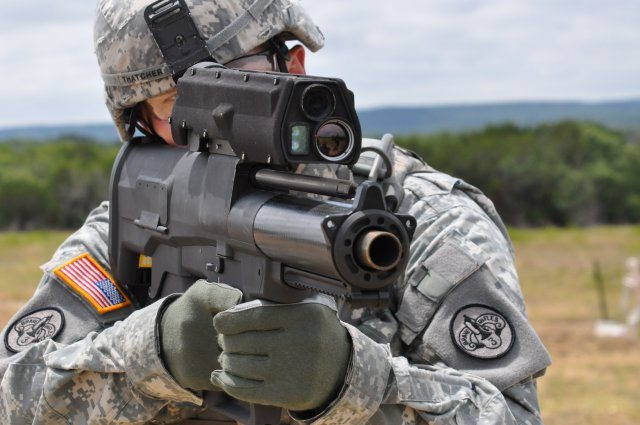The XM25 Counter Defilade Target Engagement weapon system is now in development. But by this time next year, the system may have moved into low-rate initial production and if so, will lose the experimental “X” prefix.
Lt. Col. Shawn Lucas, the PEO Soldier program manager for individual weapons at Picatinny Arsenal, N.J., said the XM25 is currently in the “engineering and manufacturing development phase,” not yet ready for fielding.
“That’s where we are developing the subsystems, which would be the weapon, the fire control, and the programmable ammunition,” he said. “[We are] integrating it all to work together at the system level so we can meet the requirements the user has asked for. If we do that, we would look to go into production.”
It’ll be about August of next year, he said, when the Army would ask decision makers to move to a “milestone C” decision with the system. That will allow them to start low-rate initial production, or LRIP, and manufacture a little more than 1,100 of the weapons, along with the needed ammunition. The LRIP decision will help prove out manufacturing processes for the weapon, the fire control and the ammunition. Additionally, those systems would then be used to do operational and live-fire testing.
Additionally, he said when that happens they would do “type-classification” on the system.
“We’d take the X off,” he said. “It’s no longer experimental; it’d be the M25.”
The XM25 was once called “the Punisher” by some of the Soldiers who initially evaluated it in Afghanistan, in November 2010. It allows Soldiers to engage defilade targets, those behind a barrier, protected from oncoming weapons fire. The system provides an advantage over traditional weapons.
“With traditional direct-fire kinds of systems that shoot in essentially a straight line, that enemy combatant would have cover from those types of weapons,” Lucas said.
The XM25 measures the distance to the enemy’s protective barrier, and can then program the round to detonate a user-adjustable distance past that, allowing Soldiers to put an air-bursting round directly above the enemy’s head, inside their protected area, even if they are behind a wall or inside a building.
“There’ s a lot of art and science in doing that, so you can get the air-bursting munitions exactly where you want in order to have the intended effect,” Lucas said.
A Soldier may use the XM25’s capability to determine that a wall protecting an enemy is some 100 meters away. The Soldier then might adjust that distance by a meter or two, so the round will travel in the air past the wall, and instead detonate directly above the intended target.
“Whoever was behind the wall would get a lot of fragments rained down on them,” Lucas said. “It’s a leap ahead, something that has never before been resident in the squad, or really our small tactical formations, squads, platoons or companies. That’s the ability to engage, and have effects on targets that are in defilade.”
The XM25 fires a programmable air-burst round that determines the distance it travels based on the number of times it rotates after leaving the barrel of the weapon. The system includes both the weapon, the rounds, and a fully-integrated day and night fire control.
Right now, Lucas said the Army is working to make more improvements to the design of the XM25, in particular to the fire control system. He also said there has been a lot of feedback concerning battery life, weight, and the size of the magazine.
Were a milestone decision to come in 2014, he said, much of 2015 would be spent testing the system, including initial operational tests, as well as the live-fire tests. They would also need to do weapons qualification, and additionally qualify the fire controls and ammunition produced off the manufacturing lines.
“Assuming success in all of those events, then you’d be able to field a unit that is then going to take those into combat operations towards the end of 2015,” he said.
Lucas said he expects the weapon will be fielded to all brigade combat teams, as well as units in U.S. Army Special Operations Command, Special Forces detachments, and Ranger Regiments.
The cost for the XM25 and the rounds it fires is expensive today, Lucas said, because the weapons and ammunition are being manufactured by hand. But with development of automated production facilities, he said the price is expected to come down to about $35,000 for the weapon and fire control system, and about $55 per round.










